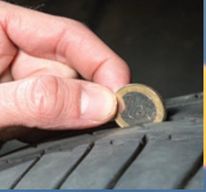Road Users
Wheel and tyre maintenance
Tread depths, tyre pressure monitoring systems, punctures, safety checks.
This content is for general information only. It does not, and is not intended to, provide legal or technical advice or to represent a legal interpretation of the matters it addresses.
Frequently asked questions
The minimum permitted tyre tread depth is 1.6 mm. For safety reasons, it is recommended that each tyre should have at least 3.0 mm tread depth. Most new tyres have 8.0 mm.
Yes. It is the central three-quarters of the tread pattern which must be greater than 1.6 mm in order to be legal for use on the road.

You can check your tyre tread depth by running a €1 coin along the centre of the wheel as illustrated. If the gold part of the coin is not visible, then the tyre tread is ok. However, if it is visible, your tyre could be approaching the minimum legal depth so you should get them checked.
The Irish Tyre Industry Association
(ITIA) offer a list of certified tyre dealers who will carry out pressure checks and inspect for tread depth, wear and damage.
It is an offence to drive with defective or worn tyres. This attracts a fine of €80 and up to four penalty points upon conviction. For more information
Download our Tyre Safety Booklet.
No, provided they meet the minimum tread depth of 1.6 mm and are free from any defects i.e., cuts, bulges, tears etc. However, all tyres over six years will receive a Pass Advisory. This is not a failure, just a precaution.
We have no authority to enforce the provision or proper maintenance of existing tyre inflation facilities at garages. It is the garage’s responsibility to maintain their equipment, and these are generally provided as a courtesy. Garages are not legally required to maintain them to an industry standard.
No. Such systems should always be maintained as per the original manufacturer’s specifications and replaced in the event of a malfunction.
This should not be re-set until the tyre pressure is correct. You will need to contact the manufacturer or refer to owner’s manual before resetting.
Currently using plugs to repair a puncture is legal when fitted to the treaded part of the tyre. However, it is illegal to have them fitted to the side wall of the tyre.
If the vehicle is blocking traffic or likely to cause an accident it should be towed immediately to the nearest place of safety or repair and the speed must not exceed 32 km/h.
Move the vehicle onto the hard shoulder, park as near as possible to the embankment, switch on hazard lights and call a recovery operator. Do not attempt to replace or repair the tyre.
No. However, under testing laws, a vehicle will fail if the two tyres on the one axle are not the same size or type e.g., radial vs. cross-ply, run-flat, winter or summer. For best performance, the same type of tyre should be fitted on all four wheels positions.
Yes. Many vehicles are supplied with a space saver or run-flat tyre or a repair kit instead of a spare wheel. Repair kits include an aerosol-based sealant inflation device. Always consult the owner’s manual. Space saver wheels are intended for emergency purposes only. The speed rating affixed to such tyres should never be exceeded to prevent possible tyre failure.
Tyres
Tyres are the only part of your vehicle in contact with the road surface. That’s why it's vital you choose the appropriate tyres and keep them correctly maintained.
Learn more
Thank you for your feedback.
